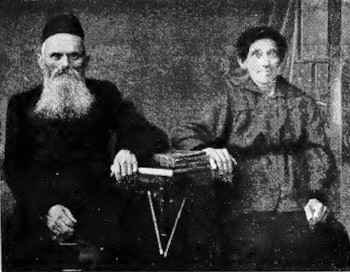 |
Reb Mordechai Finkelstein and his wife Batia
|
|
[Page 245]
52°51' 27°39'
by Nachum Chinitz
Translated by Mira Eckaus
Pahost, which is near the river Slutz, is remembered in history in the 15th century, with a population of 500. It has a Prevoslav church, a Jewish synagogue and two fairs (from the Brockhaus-Efron encyclopedia)
* * *
About two hundred Jewish families and about sixty Christian families lived in Pahost. Most of the town's residents were artisans and farmers, but there were also small merchants, shopkeepers, and peddlers. Wagon owners maintained a regular service from Pahost to Slutsk and nearby towns transporting passengers and goods.
Almost every resident took care of his own garden, had a dairy cow and raised poultry for his own needs. Two fairs were held in the town each year. On Sundays, the market was especially crowded. There were two synagogues in the town - Beit Midrash and Ker Synagogue. In the past, there was one butcher in the town, and later two, one rabbi and one shamash, who, in addition to his work in the synagogue, also served as a burier. There were also two pharmacies and a Christian medic. Until 1920, there were cheders, two government schools, one with four classes and the other with eight classes.
There are a few families from Pahost that live in Israel, among them: the Gur family (Grazovsky), the family of S. Ben-Zvi (Ratgon), the mayor of Givatayim, the Batia (Ginzburg) family and Azriel Shalev in Degania Alef, the Haim Kuntzer family.
Shimon Ben-Zvi (Ratgon)
He was born in Pahost in 5650 (1890). He received a traditional education in the cheder, at the Slutsk and Mir yeshivas. He was among the organizers of the students' group at the yeshiva, that demanded from the management to teach also general studies. The group's members were expelled from the yeshiva. He returned to Slutsk and studied there as an extern student. He made a living from teaching.
In 1914, he emigrated to Israel. He joined the labor movement, worked for a short time in Tel Adashim with HaShomer group. He worked as an agricultural laborer in Ein Chai, Ben Shemen and Petah Tikva. He was one of the first settlers in Kfar Malal (Ein Chai).
He served as the secretary of the Agricultural Workers' Histadrut (union) in Judea and ran the first workers' kitchen in Petah Tikva. He also served as the secretary of the Agricultural Workers' Histadrut (union) in Jerusalem and when the central institutions of the union moved to Tel Aviv, he also moved there.
He was the chief bookkeeper of the “Nir” company. With the foundation of the “Borochov” neighborhood, the first workers neighborhood, he was drawn to the involvement in the municipal public affairs as a resident of the place.
As the head of the council (now he serves as the mayor of Givatayim), he managed the affairs of the neighborhood for about two decades. He worked together with a number of members to unify the nearby neighborhoods called “Givatayim”. He was a member of the Haganah, one of the founders of the cooperative consumer association in the Borochov neighborhood (the first consumer association in Israel), active member in multiple institutions, a member of Ort's management, he wrote articles in ÷HaPoel HaTzairø booklet and in the book “t;The Second Aliyah”.
* * *
Pahost (Slutsk district), June 23, 1888.Not long ago, Reb Noah the Persian, known to “HaMelitz” readers by the letters printed about him in the passing year, passed through our city; And when he opened his register to show me the testimony of the rabbis of the Minsk district, about his passing there that summer, I discovered the newspaper edition number 208 of “HaMelitz”, which included the letter attesting that he is a trustworthy person and a faithful agent to his senders. As my question was not answered properly, I thought to open a discussion with him. Anyway, the matter was already published in the Beit Midrash, and Reb Noah showed all his courage there. And it was known to all that the rabbi from Priluk wrote about him in “HaMelitz” (170-5647) that he was a crook and a swindler.
Therefore, I decided his matter should be discussed publicly. He speaks in the holy language, while during his stay in Russia for the past seven years he must have already learned the spoken Jewish language. His register is not connected with a thread from page to page. He recorded in his register only part of the more decent donations (the smallest of them in the city of Starovin, 5 Rubal), and did not record the smallest donations at all. According to this, it seems that he acted with the donations as a man who acts for his own benefit. It is surprising, because in his register he mentioned only the cities in the Minsk region and none of the other cities from which he has received money for ten years. Therefore, it is appropriate that the rabbis will investigate this man, so that the public will know whether this man acts were kosher or not.
Avraham Levin
|
|
Reb Mordechai Finkelstein and his wife Batia |
|
|
JewishGen, Inc. makes no representations regarding the accuracy of
the translation. The reader may wish to refer to the original material
for verification.
JewishGen is not responsible for inaccuracies or omissions in the original work and cannot rewrite or edit the text to correct inaccuracies and/or omissions.
Our mission is to produce a translation of the original work and we cannot verify the accuracy of statements or alter facts cited.
 Slutsk, Belarus
Slutsk, Belarus
 Yizkor Book Project
Yizkor Book Project
 JewishGen Home Page
JewishGen Home Page
Copyright © 1999-2024 by JewishGen, Inc.
Updated 16 Dec 2022 by MGH